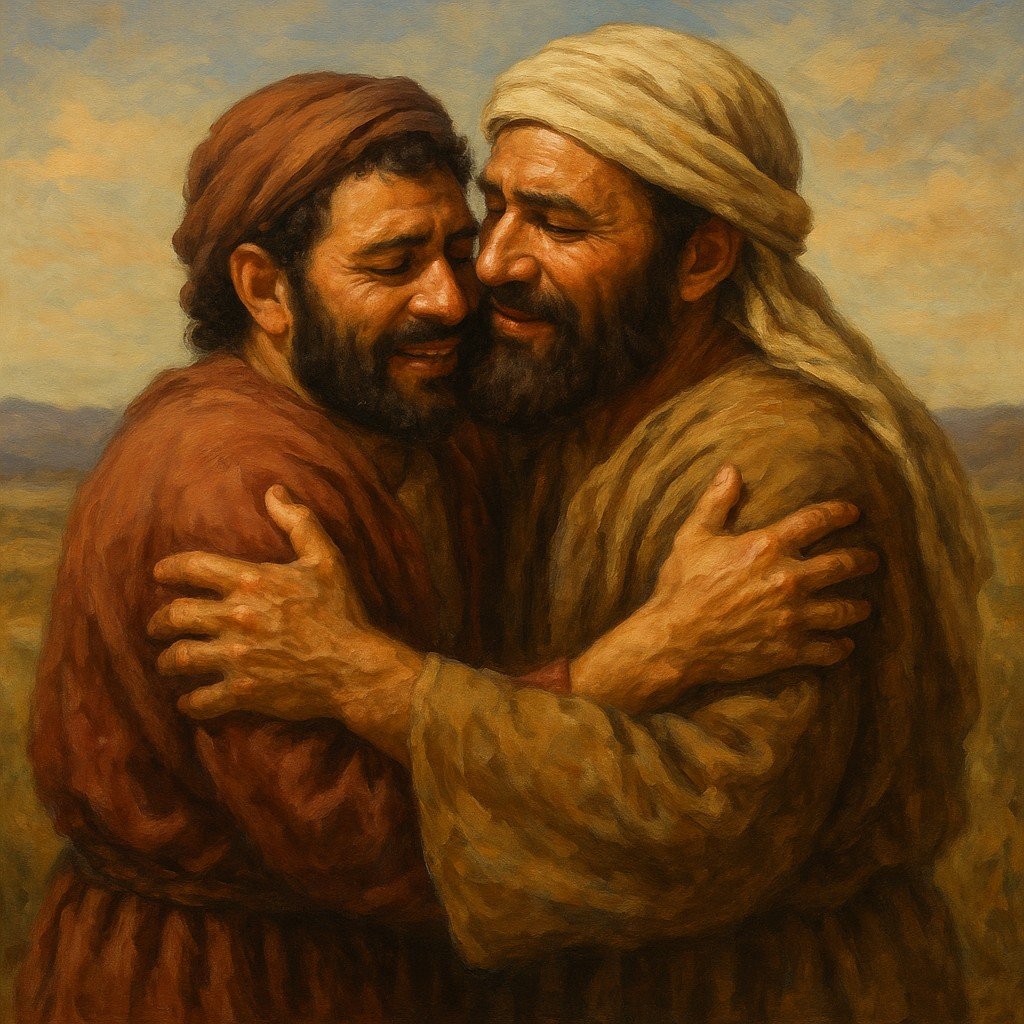Intro: What the Jacob Meets Esau Lesson Teaches About Reconciliation
The Jacob meets Esau verses in Genesis 33 (KJV) is one of the Bible’s most surprising and powerful moments of grace. After years of brokenness, fear, and separation, the brothers reunite—but not with revenge. Instead, Esau runs to embrace Jacob. For those studying forgiveness and healing in the Bible, the Jacob meets Esau lesson offers essential truths about how God works in the hearts of men.
You can read the full chapter in the Genesis 33 KJV.
1. God Can Soften Even the Hardest Hearts
Jacob feared that Esau would kill him. The last time they were together, Jacob had tricked Esau out of his birthright and blessing. But when Esau sees Jacob, he doesn’t come with anger—he comes with open arms. The Jacob meets Esau verses shows that God had worked on Esau’s heart long before Jacob ever arrived. If God can soften Esau’s heart, He can restore even the most broken relationships in your life.
2. Humility Prepares the Way for Reconciliation
Jacob bows seven times before Esau, an act of submission and respect. This display of humility shows Jacob’s repentance and vulnerability. One essential truth from the Jacob meets Esau lesson is that God values humble hearts. When pride is laid aside, God can do miraculous things.
3. Reconciliation Is a Work of God, Not Just Man
Jacob planned carefully. He sent gifts, divided his family, and prayed. But in the end, it was God—not Jacob’s strategy—that brought peace. The Jacob meets Esau verses reminds us that while we should do our part, reconciliation is ultimately a supernatural act. Only God can orchestrate peace where there was once hatred.
4. Forgiveness Doesn’t Always Require Payback
Jacob insisted that Esau accept his gifts, calling them a blessing. But Esau responded, “I have enough, my brother; keep that thou hast unto thyself” (Genesis 33:9, KJV). Esau’s grace highlights that true forgiveness releases the debt. The Jacob meets Esau lesson here is profound: real peace doesn’t come from repayment but from letting go.
5. Seeing God’s Image in Others Transforms Relationships
Jacob says something remarkable in Genesis 33:10 (KJV): “I have seen thy face, as though I had seen the face of God.” In this verse, Jacob acknowledges that seeing Esau’s forgiving face reminded him of God’s mercy. The Jacob meets Esau verses teaches that when we view others through God’s eyes, reconciliation becomes possible.
6. Peace May Lead to Separate Paths—and That’s Okay
After their emotional reunion, Jacob and Esau go their separate ways. They do not live together again. This is an important part of the Jacob meets Esau lesson—peace does not mean complete restoration of proximity. Sometimes reconciliation means forgiveness and then respectful distance. God gives wisdom for what comes next.
7. Your Story Can Become a Testimony of God’s Grace
The Jacob meets Esau verses has stood the test of time as one of the most moving scenes in the Bible. Why? Because it reflects the Gospel: the undeserved grace, the surprise of mercy, and the joy of restoration. Your reconciliation story, no matter how broken it starts, can glorify God in the same way.
Conclusion: The Ongoing Power of the Jacob Meets Esau Lesson
This moment in Genesis 33 KJV isn’t just about two brothers—it’s about you and the relationships in your life. If you’re struggling with unforgiveness, fear, or broken family bonds, remember the Jacob meets Esau lesson. God is able to heal what seems permanently fractured. You may fear wrath, but like Jacob, you could encounter unexpected mercy.
The Jacob meets Esau verses reminds us that when grace wins, God gets the glory. It is a message as essential today as it was thousands of years ago.
To continue exploring the powerful narratives in Genesis, visit our full Genesis Chapter by Chapter Summary.
Meta Description:
Explore 7 essential truths from the Jacob meets Esau verses in Genesis 33 (KJV). A powerful lesson in grace, humility, and divine reconciliation.
